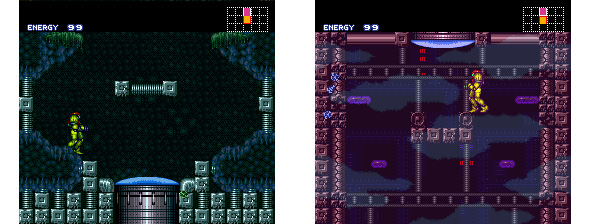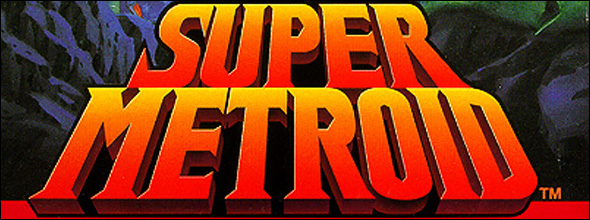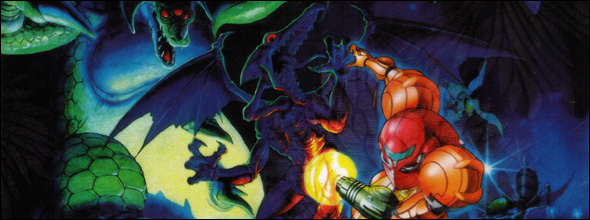Super Metroid – Open-ended Linearity
August 31st, 2010
The original Metroid has a defining flaw that would later be rectified with its successor, Super Metroid. The open-ended environments are a composition of arbitrarily posted tile sets with little sense of direction. To put it frankly, the desolate planet Zebes is a maze. As a result, there’s a certain sense of dread you often feel when playing Metroid, as it’s very easy to lead yourself astray in the oxygen-less solitude and find yourself boxed in against an insurmountable tangle of similarly-looking tiles. Super Metroid avoids the confusion by providing sufficient scaffolding to lead players along without arousing their suspicion that the experience Super Metroid offers is a well managed, staged affair. In this way, it fools the player into discovering things for themselves, when in fact our exploration is preordained, and we love it all the more for it.
Let’s take a squiz at how exactly Super Metroid appears more open-ended than it actually is. Super Metroid utilizes the SR388 overworld as a hub which connects the player to the various planetary sub-sections. Overworlds are often interpreted as de-linearating a game and offering player choice, even though oftentimes they afford no such freedoms.Super Metroid‘s overworld is a guise. Players are free to search for and enter SR388’s separate domains before the game requires them to, but on stumbling upon Brinstar, Norfair or Maridia the player quickly realizes that their progress is limited by their current selection of power-ups. In this sense, the player’s sphere of progression is not tied to the seemingly open world, but to the power suit. Therefore, the limitations enforced upon the player are not presented in a way which can be translated into tangible areas of the map, by which, the player cannot properly understand what is or isn’t within their reach. The only way that they can find out is by looking for themselves. Not only does this unknown (but never hidden) factor liberate the player’s sense of exploration, but it also persuades them to gain their own bearings of the world through actual exploration. The map is therefore a clever aid in the exploration process, since it does provide that tangible reinforcement to the player.
The individual chunks of terrain that break away to your power-ups are doorways masked as environmental puzzles, where the power-ups themselves are switches that activate the opening of doors. When a player acquires a new power-up in Super Metroid, several gates are open. Of course, Super Metroid is still linear since the gates that lead to to the next major power-up (and so on until the end of the game) are pre-determined; all players will walk the same rough path. However, Super Metroid hides this very fact in three ways. Firstly, the player may take their own route to the next mandatory gateway. Secondly, when a power-up is gained, it opens the potential for the player to access peripheral weapon upgrades (which increases the number of items held), think of them as secondary doors. And lastly, on occasion, there is more than one mandatory gateway that leads the player to the next power-up; since there is some choice, this is thereby not linear. As you can see, it’s all effectively linear, but it’s mapped around a system of diversion. No first time player will stumble upon the perfect combination of clues to lead them linearly to the end of the game. Players will inevitably be de-routed, and on their way, stumble into weapon upgrades, dead ends, previously explored areas, and walk in circles; all are tricks to create a false sense of freedom.
So, the real meat of Super Metroid are the power-ups and respective gateways which forward the progression to the end game. These are directive tools which manipulate the player’s progression. And as can be seen, Metroid is highly managed, yet we love Metroid so much because the game tricks us into thinking that we are exploring by ourselves; however, we are exploring within the confines of a mold which is ultimately linear and intentional.
Super Metroid – Establishing the Doctrine
August 19th, 2010
The original Metroid may not be as sharp as Super Metroid, but it does have one trump over its SNES successor, being its initial assertion of exploration-driven gameplay. A year prior to Metroid‘s release, Super Mario Bros. had taught players that walking to the right-hand side of the screen would advance the game. Metroid, in a master stroke of studio-wide realization and subversion, did the exact opposite: it told players to go left. If the player walked left, instead of the assumed right, at the game’s onset, they would stumble upon Metroid‘s first power-up, the morph-ball, thereby allowing the player to bypass a stumbling block a few screens to the right. As with Super Mario Bros. and that first goomba, the player cannot progress until they have understood the fundamental principles of the game. In one fell swoop, Metroid succinctly communicated its doctrine of subversive exploration.
Super Metroid‘s takes a much less momentous approach but wisely integrates the morph-ball bomb technique, which becomes a crutch for exploration throughout the entire game. Early on in Super Metroid, after the player becomes acquainted with the basic controls, they’re lead through a cavern to a seemingly dead end. They’re as stuck and confused as anyone who’d just been lead down the wrong path would be. After some fumbling about, the player will likely go back to the wall, look around until they notice that at the bottom of the wall is a block with an unsuspecting texture which mildly stands out from the fungus growing around it. A short morph-ball bomb later and—voila!—the block evaporates and the game continues.
Right there, by raising the bar high in this initial instance, Super Metroid doesn’t just set a precedence for exploration but also demands the player learn the tools (morph-ball bomb) and adopt the observation techniques (out of place textures) required to explore properly. As put by co-creator Yoshio Sakamoto in an interview with RetroGamer magazine:
We wanted players to explore everything we’d made and then move on. That’s why we designed the maps in such a way that the player couldn’t escape without exploration, or in such a way that the player would end up back at a starting point before advancing. The player would be cornered/driven and would eventually be forced to stop and say, “Right, how should I think about this area?” That’s the essential point of Metroid’s map design.
Since such a significant chunk of exploration—namely in the first half of the game, but nonetheless throughout—is based around the morph-ball bomb technique, it can be argued that Super Metroid is simply more specific with what it teaches. This makes sense as Super Metroid scaffolds tutorials around the player continuously throughout the experience in the most minute and unnoticeable ways. The original Metroid, on the other hand, sets the player up briefly and then lets them loose on a massive environment with minimal help or suggestion.
Super Metroid – The Mental Map
August 16th, 2010
Game designers create rules, a system of challenges and a gateway into that challenge (tutorial). Players, through their participation of the game world, mutually agree on the terms set by the designers. Therefore, there is something of a student and mentor relationship at work between player and designer. (Mr. Miyamoto recently commented on this phenomena a little himself). The foundation of this relationship is that of the relevant skills required to defeat the game: the teacher wishes to teach these skills, the student wishes to learn them. In which case Metroid is a test in observation and a test in the application of tools (power-ups).
Metroid‘s challenges, its tests, if you will, are built into its environment in the form of realizing suspicious chunks of area and then devising a way on how to clear that area to make progress to the next planetary subsection. Sometimes you’ll have the means to make headway, and other times you’ll need to mentally bookmark or flag down the spot to return afterwards. On a wider level though, Metroid, keeping in fashion with its exploration roots, also challenges the player in a third test of skill: the skill of mapping out one’s exploration.
In terms of what the player is constructing in their head, Metroid is an array of these “hotspots” (suspicious rooms which may be mined for progress) linked together into coherent routes and mapped around save stations. These mental pathways are connected through distinct visual markers which define particular chunks of environment from one another. When we play a Metroid game, we visualize these mental maps, with support from the in-game map itself (of which doesn’t contain the information gathered from exploration), and, in accordance to this mental map, we pursue the next string of clues.
Not only do we visualize these routes, often with aid from the map, but said routes are cross-checked against our current ability set as to whether they are viable or not to the area in question. Sometimes these clues lead us to undiscovered areas, sometimes these clues lead us to areas we’ve previously visited.
Most vividly we are concious of this play pattern right after we load the game up and begin at the last save point. It’s here that we gather our strategies and formulate a course of action, so at this point, the mental map is most relevant.
Keeping the Squeeze
Super Metroid, above all other games in the series, facilitates exploration management fantastically. The two most obvious reasons for this are the inclusion of an in-game map and the improved graphical capabilities over the original Metroid.
The in-game map works as a crutch for players to refresh their own mental map. Wisely, R&D1 chose to segment the main map away from the core gameplay by virtue of the pause screen, only offering a mini-map of surrounding rooms while the player navigates Samus. In this way, where pausing to check the map disrupts the flow of gameplay, players are persuaded into relying upon their established mental map.
With the added power of the SNES, environments – i.e. the visual markers which we use to identify and compress the landscape – are capable of being more distinct, hence making it easier for players to crystallize visual markers into their memory.
“Dead ends” – pathways that the player would preempetively follow before they receive the respective power upgrade necessary to progress in said area – from the original Metroid, now offer up minor weapon upgrades in Super Metroid, thereby decreasing player pitfalls and frustration while at the same time rewarding early curiosity.
Super Metroid is also a far more smartly segregated title than the original Metroid. The environments, while equally as large as the original Metroid, are focused into shorter, more succinct instances of play. Save points quarantine these instances of play that can later be mined for leads which allows for some dynamic threading of routes. Hub rooms, often near the entrance to a new area, take on a more skeletal structure with the purpose of each pathway conveyed more promptly. That is:
- some areas are hard blocked with sealed doors, indicating a long delay before the player revisits with new power-ups;
- some areas which require a currently-unavailable-but-soon-to-be-acquired power-up are softly marked, promptly too, as in the first room or so. Examples of these soft markers used to detract the player are a sudden absence of background music, flora and fauna met with apparent markers of essential-but-still-not-acquired weaponry (boost tracks, swinging junctions). These indicators, used to steer the player back on course, are made apparent in the first room or so (Metroid would often lead players down long corridors before confirming to players that they’re presence in the area was not currently required); and
- areas that the designers wish the player to advance through are often backed up by the respective sub-terrain theme music, denser wildlife population and a more visually “alive” environment.
The fascinating thing about Super Metroid is how the maps begin by following this skeletal structure and then, as the player subsequently revists one area multiple times over, hidden divergences bleed into the map structure (ingeniously represented by a different colour on the pause-screen map). The maps therefore begin in cocoon-like states, allowing the player to build a foundation of the environment, then, once their mental map consolidates, the pathways blossom into one another as reliance on the in-game map fades.
With the bleeding of the map, cleaner visual markers, fewer dead ends, a more logical and directed conveyance of purpose within the environments, Super Metroid constantly feeds the player’s mental map and thereby continuously drills the emergent skill of exploration management.








 Game Design Companion: A Critical Analysis of Wario Land 4 - $7.99
Game Design Companion: A Critical Analysis of Wario Land 4 - $7.99 Level Design: Processes and Experiences
Level Design: Processes and Experiences Speed Boost: The Hidden Secrets Behind Arcade Racing Design - $5.99
Speed Boost: The Hidden Secrets Behind Arcade Racing Design - $5.99 Adventures in Games Analysis: Volume I - $5.99
Adventures in Games Analysis: Volume I - $5.99







